The Whooping Crane (Grus americana) stands as an emblem of both majesty and conservation urgency.
With its striking white plumage, towering stature, and resonant calls, this North American crane species captivates the imagination of bird enthusiasts worldwide.
However, the Whooping Crane’s story is not just one of beauty; it is also a narrative of resilience and conservation.
Once on the brink of extinction due to habitat loss and hunting pressures, concerted conservation efforts have brought this iconic bird back from the brink.
Today, the Whooping Crane serves as a symbol of hope, highlighting the importance of habitat preservation, species recovery programs, and international cooperation in safeguarding endangered species.
Understanding the intricacies of the Whooping Crane’s biology, behavior, and conservation needs is essential for ensuring its continued survival in the wild. Stay sharp.
Identifying Criteria of Whooping Crane
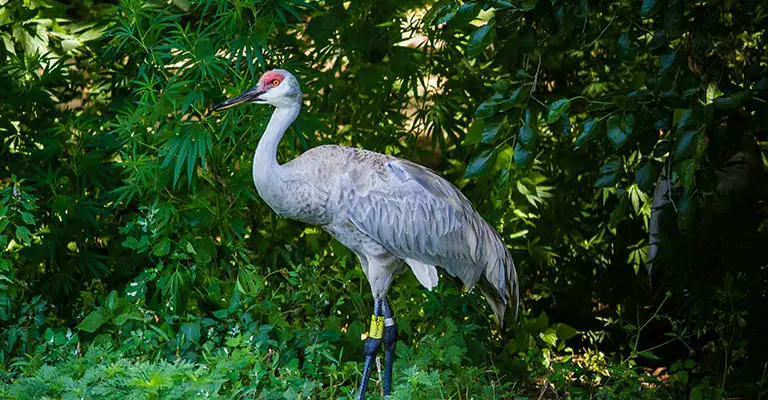
Identifying the majestic Whooping Crane (Grus americana) can be an exhilarating experience for bird enthusiasts and naturalists alike.
These iconic birds, known for their striking appearance and distinctive calls, are the tallest birds in North America and hold a special place in conservation efforts due to their endangered status.
Here are some of the key points to help identify these remarkable creatures:
Size and Appearance
Whooping Cranes are large birds with a height of about 5 feet (1.5 meters) and a wingspan of around 7 feet (2.1 meters). They have long, slender necks, legs, and bills.
Their plumage is primarily white, with black wingtips that are visible in flight. Juveniles have patches of cinnamon-brown feathers on their heads and necks, which gradually turn white as they mature.
Distinctive Calls
One of the most recognizable features of Whooping Cranes is their loud, trumpeting call. Their calls can carry over long distances and are often described as a series of deep, resonant “whoops.”
These calls serve various purposes, including communication between mates, signaling danger, and maintaining social bonds within their family groups.
Habitat
Whooping Cranes are primarily found in wetland habitats, including marshes, mudflats, and shallow coastal areas.
During the breeding season, they inhabit remote wetlands in northern regions such as Canada and parts of the United States, while they migrate to warmer coastal areas in the southern United States during the winter months.
Behavior
Observing the behavior of Whooping Cranes can also aid in identification. They are often seen foraging in shallow water, using their long bills to probe for prey such as crustaceans, insects, and small fish.
When flying, their long necks are extended straight out, and their legs trail behind, giving them a distinctive silhouette.
Flight Pattern
Whooping Cranes have a slow, graceful flight characterized by steady wingbeats and gliding.
Their black wingtips are visible during flight, contrasting sharply against their white plumage. They often fly in a V-formation during migration, similar to other crane species.
Range and Distribution
Whooping Cranes have a limited range, primarily restricted to North America.
Historically, they ranged across much of the continent, but habitat loss and hunting pressure drastically reduced their population.
Today, efforts are underway to reintroduce and protect populations in designated breeding and wintering areas.
Conservation Status
Given their endangered status, conservation efforts play a crucial role in safeguarding Whooping Crane populations.
Identification of these birds can contribute to monitoring and conservation initiatives, helping researchers track population trends and assess the effectiveness of conservation measures.
Leg Bands and Markings
Some Whooping Cranes may be marked with leg bands or radio transmitters as part of research and conservation programs.
These markings can provide valuable information about individual birds and their movements, aiding in identification and monitoring efforts.
Identifying Whooping Cranes requires careful observation of their size, appearance, calls, habitat, behavior, flight pattern, range, and any identifying markings.
By familiarizing themselves with these key characteristics, birdwatchers and conservationists can contribute to the protection and preservation of these magnificent birds for future generations to admire and appreciate.
Taxonomy of Whooping Crane
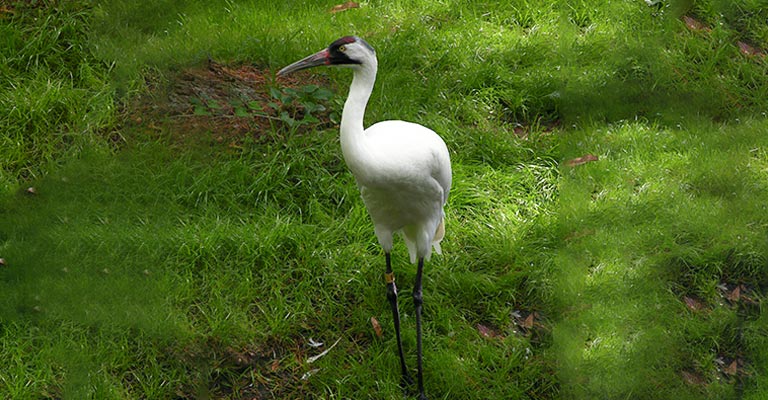
Here’s a nice table summarizing the taxonomy details of the Whooping Crane:
| Domain | Eukaryota |
| Kingdom | Animalia |
| Phylum | Chordata |
| Class | Aves |
| Order | Gruiformes |
| Superfamily | Gruoidea |
| Family | Gruidae |
| Genus | Grus |
| Species | G. americana |
The Whooping Crane (Grus americana) belongs to the family Gruidae within the order Gruiformes.
This crane species is classified under the genus Grus, which comprises large, long-legged birds known for their graceful appearance and distinctive calls.
Within the Gruidae family, the Whooping Crane is part of the subfamily Gruinae, which includes other crane species such as the Sandhill Crane. Its specific epithet, “Americana,” reflects its native range in North America.
Taxonomically, the Whooping Crane is closely related to other crane species but is distinguished by its unique vocalizations, striking plumage, and endangered status.
Common Food of Whooping Crane
Whooping Cranes are primarily carnivorous birds with a diverse diet consisting of various aquatic and terrestrial organisms. Their common food habits include:
- Crustaceans: Whooping Cranes feed on small crustaceans such as crabs and crayfish found in wetland habitats.
- Insects: They consume a variety of insects, including beetles, grasshoppers, and dragonflies, often foraging in grasslands and marshes.
- Fish: Fish make up a significant portion of their diet, with Whooping Cranes preying on small fish species in shallow water bodies.
- Amphibians: Amphibians like frogs and tadpoles are also part of their diet, particularly during the breeding season when they inhabit wetland areas.
- Small Mammals: Occasionally, Whooping Cranes may consume small mammals such as mice and voles when available in their habitat.
- Plant Matter: While predominantly carnivorous, Whooping Cranes may also incidentally ingest plant material such as seeds and grains while foraging in wetland habitats.
Their varied diet reflects their adaptation to diverse ecosystems and habitats across their range.
Whooping Crane Life History
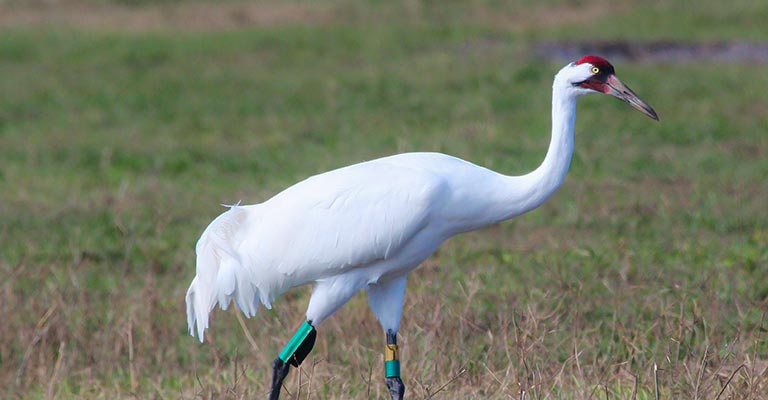
The Whooping Crane (Grus americana) stands as a symbol of resilience and conservation efforts due to its endangered status and captivating life history.
From its habitat preferences to breeding behaviors and the challenges it faces in the wild, understanding the life history of this majestic bird sheds light on the importance of conservation initiatives aimed at its preservation.
Habitat
Whooping Cranes primarily inhabit wetland ecosystems such as marshes, mudflats, and shallow coastal areas.
During the breeding season, they seek out remote wetlands in northern regions while they migrate to warmer coastal areas in the southern United States during the winter months. These habitats provide the necessary resources for foraging, nesting, and rearing young.
Range Map
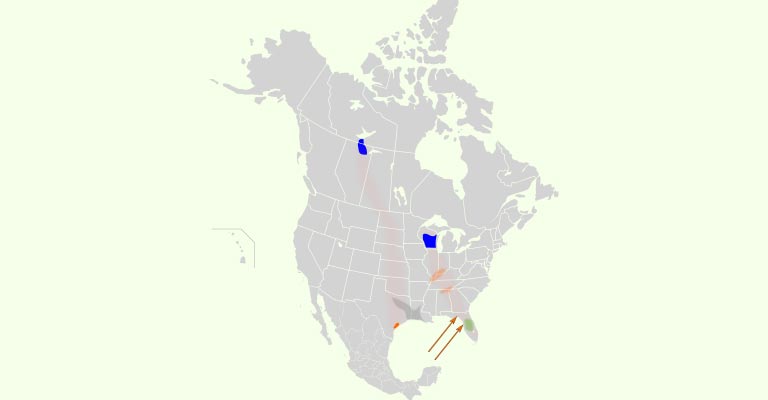
A range map illustrates the seasonal movements and distribution of Whooping Cranes across North America.
It showcases their breeding grounds in the northern regions of Canada and the United States, their migratory routes to wintering areas along the Gulf Coast of Texas and Florida, as well as occasional sightings in other parts of the continent during migration.
Breeding
Breeding for Whooping Cranes typically occurs in the spring and summer months. They form monogamous pairs and engage in elaborate courtship displays, including dancing and vocalizations.
Nests are constructed in wetland habitats, usually consisting of mounds of vegetation placed in shallow water.
Females lay one to two eggs, and both parents share incubation duties. Chicks hatch after about a month, and parents care for them diligently until they fledge and become independent.
Diseases and Treatment
Whooping Cranes are susceptible to various diseases, including avian botulism, West Nile virus, and lead poisoning.
Conservation efforts often involve monitoring and addressing disease outbreaks through vaccination programs, habitat management, and providing supplementary food sources to mitigate the effects of disease on wild populations.
Conservation
Due to habitat loss, hunting, and other human-induced threats, Whooping Cranes faced a drastic decline in population numbers.
Conservation efforts, including captive breeding programs, habitat restoration, and protection measures, have been instrumental in stabilizing populations and reintroducing birds into the wild.
Ongoing monitoring and research contribute to the continued conservation of this iconic species, ensuring its survival for generations to come.
Understanding the intricacies of the Whooping Crane’s life history highlights the interconnectedness between the species and its environment, underscoring the importance of conservation efforts in safeguarding biodiversity and preserving ecosystems.
Nesting Habit of Whooping Crane
Check out the following table detailing the nesting habits of the Whooping Crane:
| Nesting Detail | Description |
| Clutch Size | 1-2 eggs |
| Number of Broods | Usually 1 per breeding season |
| Egg Length | Approximately 13-14 centimeters (5-5.5 inches) |
| Egg Width | Approximately 8-9 centimeters (3-3.5 inches) |
| Incubation Period | About 29-31 days |
| Nestling Period | Approximately 80-100 days |
| Egg Description | Creamy white with a slightly rough texture |
| Nest Construction | Constructed in shallow water on a mound of vegetation |
| Nest Placement | Typically located in wetland habitats |
| Parental Care | Both parents share incubation and chick rearing duties |
| Fledging | Chicks fledge and become independent around 80-100 days |
These details provide insights into the reproductive behavior and nesting habits of Whooping Cranes, highlighting their adaptations to wetland environments and the care they invest in raising their offspring.
Whooping Cranes construct their nests in shallow water, typically in remote wetland habitats. The nests are built atop mounds of vegetation to provide elevation and protection from flooding.
Females lay one to two creamy-white eggs, which both parents incubate for about 29-31 days. During this period, the parents diligently tend to the nest, rotating incubation duties.
After hatching, the chicks remain in the nest for approximately 80-100 days, during which time they are cared for and nurtured by both parents.
The nesting habits of Whooping Cranes reflect their adaptation to wetland ecosystems and the importance of suitable habitat for successful reproduction.
5 Behavioral Habits of Whooping Crane
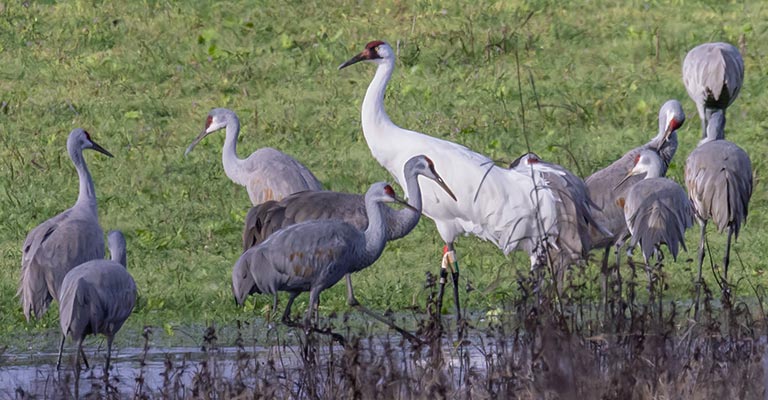
Understanding the behavioral habits of Whooping Cranes offers valuable insights into their ecology and social dynamics.
From their courtship displays to foraging behaviors, these majestic birds exhibit a range of fascinating behaviors that contribute to their survival and reproductive success.
Courtship Displays
Whooping Cranes engage in elaborate courtship displays, including dancing, bowing, and vocalizations. These displays strengthen pair bonds and are essential for mate selection.
Territorial Behavior
During the breeding season, Whooping Cranes defend their nesting territories from intruders, often displaying aggressive behaviors towards other cranes or potential threats.
Parental Care
Both parents play active roles in raising their offspring, sharing responsibilities such as nest building, incubation, and feeding.
They exhibit attentive care towards their chicks, ensuring their survival during the vulnerable early stages of life.
Foraging Strategies
Whooping Cranes employ various foraging techniques to obtain food from wetland habitats. They use their long bills to probe for prey in shallow water, feeding on a diverse diet of crustaceans, insects, fish, and plant matter.
Migration Patterns
Whooping Cranes undertake long-distance migrations between breeding and wintering grounds, following established flyways.
Their migration behavior is guided by environmental cues and instinct, ensuring they reach suitable habitats for breeding and overwintering.
These behavioral habits highlight the adaptability and resourcefulness of Whooping Cranes in their natural environment, underscoring the importance of habitat conservation and protection for their continued survival.
Wrapping Up
The Whooping Crane, with its majestic presence and intricate life history, serves as a beacon of conservation and ecological importance.
Understanding its habitat preferences, nesting habits, behavioral patterns, and the challenges it faces underscores the urgent need for concerted conservation efforts.
By safeguarding wetland habitats, mitigating human-induced threats, and implementing effective management strategies, we can ensure the survival of this iconic species for future generations to admire and cherish. Thank you very much.